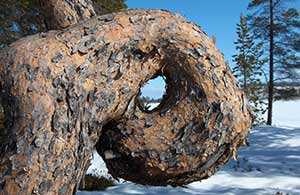The Inari Sámis, like other Sámis worshipped natural gods, or as is taught in our schools, heathen (false) gods. The greatest of all gods was “Aijih” (God of thunder, Ukko), whose most important sacrificial site was Äijihsuálui (Ukonsaari Island). His wife was “Ákku” (Grandmother, Old Woman) and she lived to the north of Ivalo at Ukonjärvi Lake. There is a ridge there named Ákku, from which, according to ancient legend, an underground tunnel led straight to Ukonsaari Island. Through this tunnel, the deific couple was able to communicate together. Other gods were “Piäiváž” (the Sun) who was sacrificed to at midsummer and in autumn, “Čäcialmai” (Water Man) who was prayed to on midsummer night on the shores of rapids, “Pieggalmai” (Wind Man), who was sacrificed to on Tuulispää Fell and “Siedie” (Seita), who was a very precise and strict God. The Seita was so holy, that one had to approach it on hands and knees. The Seita Access to some holy sites was a privilege granted only to men and to women only if they were dressed like a man. Ukonsaari Island on Lake Inari and Seitasaari Island of Pisteriniemi were these kinds of sacred islands. Women had their own sacrificial site on Naarassaari Island which is located on the western side of the open waters of Kasari on Lake Inari. Dogs were also not permitted access to the holy places, but this may have been for practical reasons, because dogs being irrational animals would not have left the sacrifices alone, but would have carried them all over the island and perhaps eaten them. Sacrificing to a fish seita occurred by annointing the seita with sacrificial broth, which was usually fish fat, and the best driving deer’s antlers , reindeer skulls and bones were sacrificed to the reindeer seita. The deer seita received heads with the antlers still on them, marrow bones and sometimes even whole animals. The seita may have been a special looking natural rock or a man-made cairn of stones, or it was constructed of wood. There were together 17 seitas of these kinds in the Inari area, but it must be assumed that these seitas were hardly even half of all that existed, because they were systematically destroyed, as were all the shaman drums in Finnish Lapland.
The Inari Sámis also had numerous natural spirits, nearly 50, that cared for many things, such as reindeer, the kota, the harvest of the forest and water, etc. These spirits were mostly good willed like the “kuhvittâr”, who was a rich and beautiful underground sprite, the “čáhálig”, who was a half meter tall and child-faced treasure sprite and “juovlâstáálu” (Christmas Staalo) now known as Santa Claus, who was able to drive all the animals of the forest. There were as well a great deal of various forest sprites. But there were also bad willed sprites, such as “stáálu” (staalo), “peinijâž” (nightmare) and “komme” (ghost”), etc. When priests happened to visit remote Inari, they had to fight with all these old beliefs and false gods with all their might. The Shaman The shaman was the most important person of the village whose task was to ward off all evil. He may have received his function due to his innate gifts or inherited from his father who happened to be a shaman. He became more adept through practice. There were mainly two kinds of shaman, good willed and bad willed. The village shaman belonged to the good willed sort. The flying shaman, who could shift place at the speed of the wind, belonged to an elite among shamans. He could appear sometimes as a bird, or as some other kind of animal. Another kind of shaman could on the other hand leave his own body and appear, for example, in the shape of an animal or fish. If the animal or fish happened to be hurt when the shaman was in that guise, the wound could stay with him permanently. This could be disastrous for the shaman, as he had to always be healthy. The smallest injury could prevent him from being considered a fully qualified shaman. The Shaman’s Drum The shaman’s drum was the most important tool of the shaman’s trade, which included a baton and charm. The cover was beaten by a baton and the charm moving on the cover predicted the future. In Kemi-Lapland and evidently also in Inari, the cover was divided into three parts: upper zone, middle zone and lower zone. There were gods in the upper zone, seitas and sacrificial places with people in the middle zone, and the inhabitants of the Underworld with their own gods in the lower zone. An exception to this kind of cover was possibly a drum from Utsjoki the cover of which was divided into five parts. The three upper parts depict the different levels of the sky, the fourth the earth and the lower the Underworld. There are numerous Christian symbols on the drum and it is not surprising that drum making would absorb Christian influences from Inari, for example. Ilmari Mattus
|
|

